A definitive Cy Twombly retrospective reasserts his status as a modern master
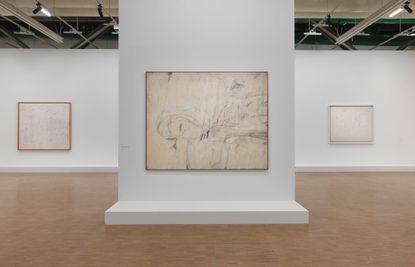
In the autumn of 1963, John F Kennedy was assassinated in Dallas, Texas. His wife, Jackie Kennedy, was wearing a strawberry pink suit at the time. She famously insisted on wearing it – still stained with his blood – during the swearing-in of Lyndon B Johnson and for the flight back to Washington DC with the president’s body.
It was this pivotal event – and sartorial detail – that the late American painter Cy Twombly devoted a cycle of paintings to immediately after. The 1963 series Nine Discourses on Commodus would go on show the following spring at Leo Castelli’s gallery in New York. As the story goes, Twombly didn’t travel with the works and they were installed without him in the wrong order. Critics vehemently derided the exhibition. Donald Judd wrote a ‘killer review’; others proclaimed they were ‘old-fashioned’ and ‘too European’.
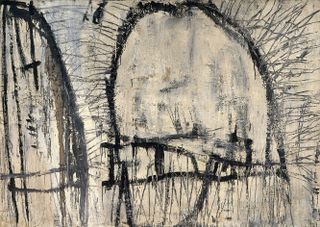
‘Volubilis’, 1953.
Now, these remarkable works are on display at the Centre Pompidou as part of a definitive retrospective opened in Paris, the first since the artist’s death in 2011. Centred on three major cycles – the aforementioned Nine Discourses on Commodus; Fifty Days at Iliam (1978); and Coronation of Sesostris (2000) – the survey spans Twombly’s 60-year career through some 140 paintings, drawings, photographs and sculptures mapped out chronologically.
Born in 1928 in Lexington, Virginia, Edwin Parker Twombly adopted his father’s nickname, ‘Cy’ (after the baseball player Cyclone Young). His affinity for art formed early on, nourished by the guidance of the Spanish artist Pierre Daura. By 1950, Twombly found himself studying in New York, where he would meet artists Robert Rauschenberg and Jasper Johns; the trio would forge a deep, lifelong friendship, influencing each other’s artistic practices. (In serendipitous symmetry, Rauschenberg is also the current subject of a major retrospective at Tate Modern in London).

‘Blooming’, 2001–2008.
The show opens with a painting exhibited at Twombly’s first solo exhibition at Stable Gallery in New York in 1955. It’s a work that the artist kept all his life, ‘unique’ in its semi-figurative nature. Among the graffiti-like scrawls, an eye stares down visitors at the entrance. As curator Jonas Storsve explains, ‘The visitor watches the painting, at the same time the painting looks back.’
It’s a sentiment that carries throughout the show. Personal anecdotes of love, sex and death pervade Twombly’s works, but the cryptic artist always deftly deflects, citing various real-world events or Greco-Roman influences.

The retrospective closes with works produced at the end of Twombly’s career, in his studio in Gaeta. © Centre Pompidou.
Twombly’s artistic transformation is explored in earnest at the Centre Pompidou. Along the way, visitors also get a glimpse into other lesser-known facets of his practice – an array of his sculptures perfectly punctuate the exhibition halfway through, while his Polaroids are a revelation. (The enigmatic Twombly photographed quite extensively throughout his career, but only first revealed these images in the 1990s.)
In 2005, at the height of the Iraq War, Twombly embarked on an epic series of paintings in his Gaeta studio. Returning to the characteristic writing he had explored in the Black Paintings of the late 1960s, the Bacchus series serves as the show-stopping finale; potent, swirling canvases of blood-red paint allude to wine and death at once. Twombly’s evolution is complete.
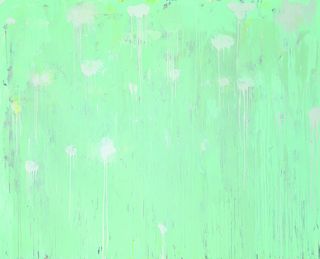
‘Sans titre (A Gathering of Time)’, 2003.
The Centre Pompidou retrospective – comprehensive, but arguably incomplete – does an immense service to Twombly’s oeuvre, unfurling the complexities of an artist oft maligned in his time, but certainly not now.

The major survey spans Twombly’s 60-year career through some 140 paintings, drawings, photographs and sculptures mapped out chronologically. Pictured, Untitled (Lexington), 1951.

Still Life, Black Mountain College, 1951.
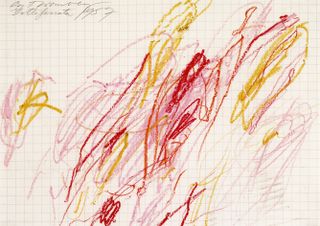
Untitled (Grottaferrata), 1957.
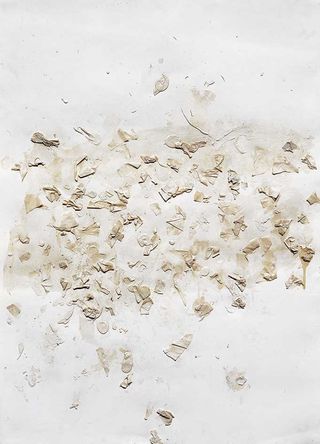
Sperlong Collage, 1959.

The fourth room of the exhibition is dedicated to works the artist produced in Rome between 1960 and 1962, following his marriage to Italian aristocrat Luisa Tatiana Franchetti. Twombly produced some of his most sexual paintings during this period. © Centre Pompidou.
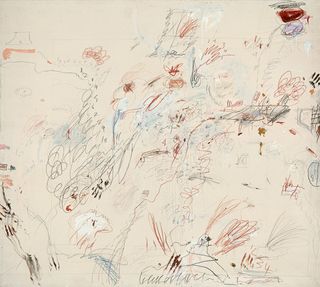
Dutch Interior, 1962.

In late 1963, following John F Kennedy’s assassination, Twombly devoted a cycle of nine paintings to the Roman emperor Commodus (161–192), son of Marcus Aurelius and remembered as a cruel and bloodthirsty ruler
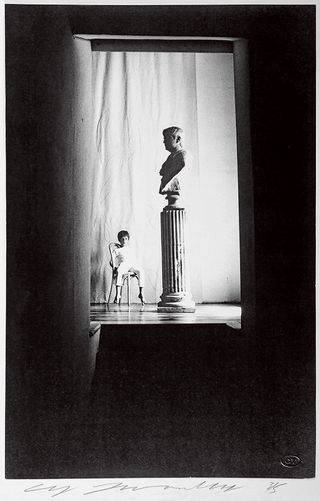
The Paris exhibition was organised with the support of the artist’s son, Alessandro Twombly – the show includes this 1965 portrait of him as a child.
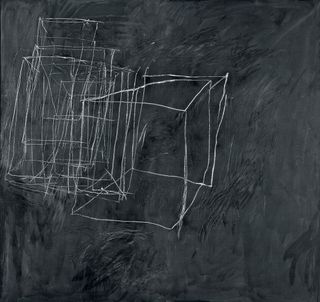
Night Watch, 1966. , Inc; and Cheim & Read
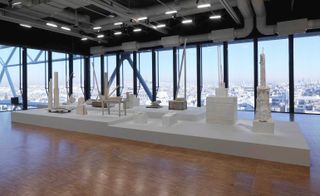
Visitors also get a glimpse into other lesser-known facets of Twombly’s practice – an array of his sculptures perfectly punctuate the exhibition halfway through. © Centre Pompidou.

In 1975, Twombly bought a 16th-century house at Bassano in Teverina, north of Rome, establishing his summer studio there. Inspired by Homer’s Iliad, read in Alexander Pope’s 18th-century English translation, he embarked in 1977 on the major cycle Fifty Days at Iliam, the ten paintings in which were completed over two successive summers. © Centre Pompidou.
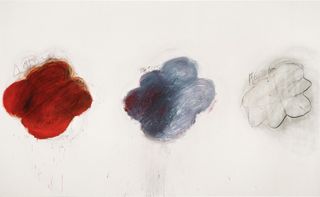
Fifty Days at Iliam Shades of Achilles, Patroclus and Hector, 1978.
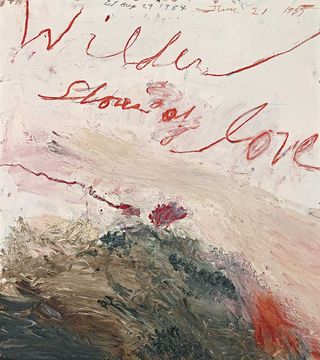
Wilder Shores of Love, 1985.

Summer Madness, 1990.
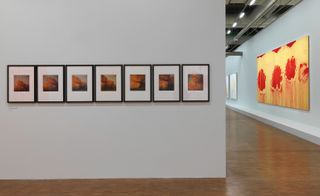
A selection of Twombly’s Polaroids are also on show as part of the survey.© Centre Pompidou

These images recall the work of the Italian painter Giorgio Morandi. Pictured, Lemons, 1998.

Coronation of Sesostris is one of the major painting cycles that punctuated Twombly’s career, differing from the purely abstract series in its incorporation of narrative elements. © Centre Pompidou.

The cycle is inspired by the god Râ, whose two sun-boats traversed the heavens both day and night. © Centre Pompidou.
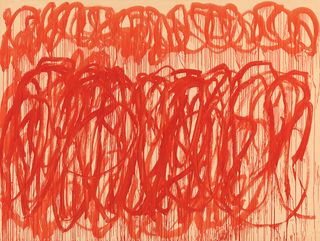
For the Bacchus series, painted at Twombly’s Gaeta studio in early 2005, the artist again remembered Homer’s Iliad and returned to the writing he had explored in the Black Paintings of the late 1960s. Pictured, Untitled (Bacchus), 2005.

Here, he replaced the white wax crayon with red paint evocative of both blood and wine, allowed to run freely across the vast canvases. © Centre Pompidou.
INFORMATION
‘Cy Twombly’ is on view until 24 April. For more information, visit the Centre Pompidou website
Wallpaper* Newsletter
Receive our daily digest of inspiration, escapism and design stories from around the world direct to your inbox
ADDRESS
Centre Pompidou
Place Georges-Pompidou
75004 Paris
-
 Ikea introduces its first gaming furniture collection
Ikea introduces its first gaming furniture collectionBrännboll is the first Ikea gaming furniture collection, unveiled during Milan Design Week 2024 and designed to swiftly transform a domestic space into a gamer’s paradise
By Jasper Spires Published
-
 Morgan take their classic roadster and give it subtle but significant tweaks for 2024
Morgan take their classic roadster and give it subtle but significant tweaks for 2024New details and features give the compulsive Morgan Plus Four an even more pared back silhouette and driving ability
By Jonathan Bell Published
-
 Wallpaper* Class of '24 exhibition now open at Triennale Milano
Wallpaper* Class of '24 exhibition now open at Triennale MilanoWallpaper* Class of '24 exhibition at Triennale spotlights international emerging talent in furniture and product design, with the support of AHEC and SNOW (until 21 April 2024)
By Rosa Bertoli Published
-
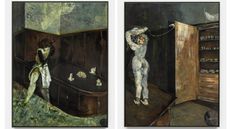 Guglielmo Castelli considers fragility and violence with painting series in Venice
Guglielmo Castelli considers fragility and violence with painting series in VeniceGuglielmo Castelli’s exhibition ‘Improving Songs for Anxious Children’ at Palazzetto Tito, Venice, explores childhood as the genesis of discovery
By Sofia Hallström Published
-
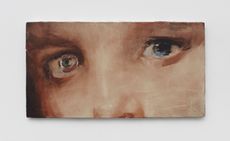 ‘Accordion Fields’ at Lisson Gallery unites painters inspired by London
‘Accordion Fields’ at Lisson Gallery unites painters inspired by London‘Accordian Fields’ at Lisson Gallery is a group show looking at painting linked to London
By Amah-Rose Abrams Published
-
 Josèfa Ntjam reveals mythical sculptures for her LVMH Métiers d’Art artist residency
Josèfa Ntjam reveals mythical sculptures for her LVMH Métiers d’Art artist residencyLVMH Métiers d’Art presents ‘Une cosmogonie d’océans’, celebrating Josèfa Ntjam’s artistic residence
By Tianna Williams Published
-
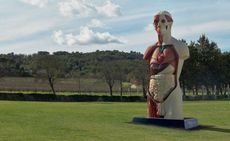 Damien Hirst takes over Château La Coste
Damien Hirst takes over Château La CosteDamien Hirst’s ‘The Light That Shines’ at Château La Coste includes new and existing work, and takes over the entire 500-acre estate in Provence
By Hannah Silver Published
-
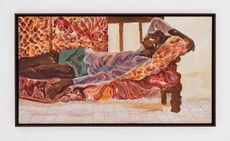 Ludovic Nkoth’s vibrant paintings reflect on migration
Ludovic Nkoth’s vibrant paintings reflect on migrationCameroon-born, New York-based Ludovic Nkoth uses acrylic paint to strike a balance between abstraction and figuration
By Ugonna-Ora Owoh Published
-
 Heads up: art exhibitions to see in January 2024
Heads up: art exhibitions to see in January 2024Start the year right with the Wallpaper* pick of art exhibitions to see in January 2024
By Hannah Silver Published
-
 Tia-Thuy Nguyen encases Chateau La Coste oak tree in tonne of stainless steel strips
Tia-Thuy Nguyen encases Chateau La Coste oak tree in tonne of stainless steel stripsTia-Thuy Nguyen’s ‘Flower of Life’ lives in the grounds of sculpture park and organic winery Château La Coste in France
By Harriet Quick Published
-
 Paris Photo 2023: Eva Nielsen puts our impact on the Camargue in dynamic focus
Paris Photo 2023: Eva Nielsen puts our impact on the Camargue in dynamic focusAt Paris Photo 2023, ‘Insolare’ by Eva Nielsen, in collaboration with BMW Art Makers, is a compelling exploration of human impact on the landscape
By Sophie Gladstone Published